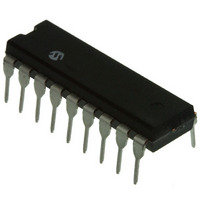PIC16LC711-04/P Microchip Technology, PIC16LC711-04/P Datasheet - Page 24

PIC16LC711-04/P
Manufacturer Part Number
PIC16LC711-04/P
Description
IC MCU OTP 1KX14 A/D 18DIP
Manufacturer
Microchip Technology
Series
PIC® 16Cr
Specifications of PIC16LC711-04/P
Core Size
8-Bit
Program Memory Size
1.75KB (1K x 14)
Oscillator Type
External
Core Processor
PIC
Speed
4MHz
Peripherals
Brown-out Detect/Reset, PWM, WDT
Number Of I /o
13
Program Memory Type
OTP
Ram Size
68 x 8
Voltage - Supply (vcc/vdd)
2.5 V ~ 6 V
Data Converters
A/D 4x8b
Operating Temperature
0°C ~ 70°C
Package / Case
18-DIP (0.300", 7.62mm)
Controller Family/series
PIC16LC
No. Of I/o's
13
Ram Memory Size
68Byte
Cpu Speed
4MHz
No. Of Timers
1
Digital Ic
RoHS Compliant
Lead Free Status / RoHS Status
Lead free / RoHS Compliant
Eeprom Size
-
Connectivity
-
Lead Free Status / RoHS Status
Lead free / RoHS Compliant
Available stocks
Company
Part Number
Manufacturer
Quantity
Price
- Current page: 24 of 177
- Download datasheet (2Mb)
PIC16C71X
Example 4-1 shows the calling of a subroutine in
page 1 of the program memory. This example assumes
that PCLATH is saved and restored by the interrupt ser-
vice routine (if interrupts are used).
EXAMPLE 4-1:
ORG 0x500
BSF
BCF
CALL
ORG 0x900
SUB1_P1:
RETURN
FIGURE 4-15:
DS30272A-page 24
RP1:RP0
bank select
For register file map detail see Figure 4-4.
Note 1:
PCLATH,3
PCLATH,4
SUB1_P1
:
:
:
:
:
location select
6
Direct Addressing
The RP1 and IRP bits are reserved, always maintain these bits clear.
Data
Memory
DIRECT/INDIRECT ADDRESSING
CALL OF A SUBROUTINE IN
PAGE 1 FROM PAGE 0
;Select page 1 (800h-FFFh)
;Only on >4K devices
;Call subroutine in
;page 1 (800h-FFFh)
;called subroutine
;page 1 (800h-FFFh)
;return to Call subroutine
;in page 0 (000h-7FFh)
from opcode
00h
7Fh
Bank 0
00
0
80h
FFh
Bank 1
01
100h
17Fh
Bank 2
10
4.5
The INDF register is not a physical register. Addressing
the INDF register will cause indirect addressing.
Indirect addressing is possible by using the INDF reg-
ister. Any instruction using the INDF register actually
accesses the register pointed to by the File Select Reg-
ister, FSR. Reading the INDF register itself indirectly
(FSR = '0') will read 00h. Writing to the INDF register
indirectly results in a no-operation (although status bits
may be affected). An effective 9-bit address is obtained
by concatenating the 8-bit FSR register and the IRP bit
(STATUS<7>), as shown in Figure 4-15. However, IRP
is not used in the PIC16C71X devices.
A simple program to clear RAM locations 20h-2Fh
using indirect addressing is shown in Example 4-2.
EXAMPLE 4-2:
NEXT
CONTINUE
Used
Not
180h
1FFh
Bank 3
11
Indirect Addressing, INDF and FSR
Registers
movlw
movwf
clrf
incf
btfss
goto
:
IRP
bank select
(1)
0x20
FSR
INDF
FSR,F
FSR,4
NEXT
INDIRECT ADDRESSING
7
Indirect Addressing
1997 Microchip Technology Inc.
;initialize pointer
;to RAM
;clear INDF register
;inc pointer
;all done?
;no clear next
;yes continue
FSR register
location select
0
Related parts for PIC16LC711-04/P
Image
Part Number
Description
Manufacturer
Datasheet
Request
R

Part Number:
Description:
IC MCU OTP 1KX14 A/D 18DIP
Manufacturer:
Microchip Technology
Datasheet:

Part Number:
Description:
IC MCU OTP 1KX14 A/D 18SOIC
Manufacturer:
Microchip Technology
Datasheet:

Part Number:
Description:
IC MCU OTP 1KX14 A/D 18SOIC
Manufacturer:
Microchip Technology
Datasheet:

Part Number:
Description:
IC MCU OTP 1KX14 A/D 18DIP
Manufacturer:
Microchip Technology
Datasheet:

Part Number:
Description:
Manufacturer:
Microchip Technology Inc.
Datasheet:

Part Number:
Description:
Manufacturer:
Microchip Technology Inc.
Datasheet:

Part Number:
Description:
Manufacturer:
Microchip Technology Inc.
Datasheet:

Part Number:
Description:
Manufacturer:
Microchip Technology Inc.
Datasheet:

Part Number:
Description:
Manufacturer:
Microchip Technology Inc.
Datasheet:

Part Number:
Description:
Manufacturer:
Microchip Technology Inc.
Datasheet:

Part Number:
Description:
Manufacturer:
Microchip Technology Inc.
Datasheet:











